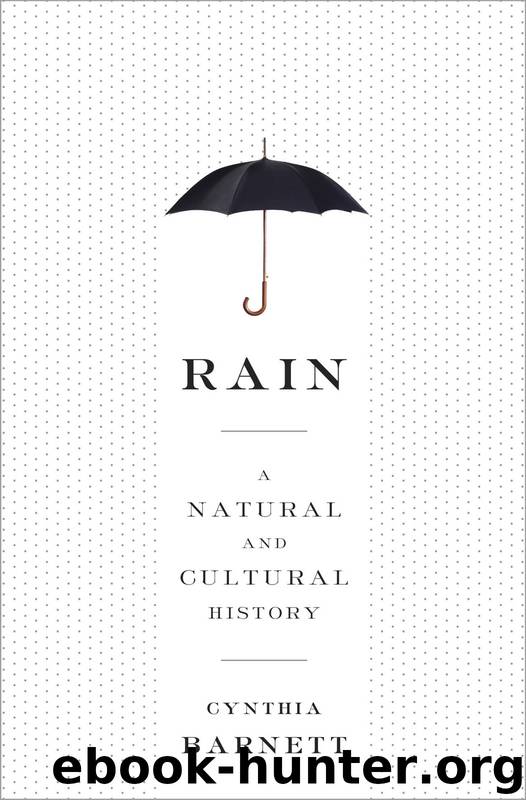Rain: A Natural and Cultural History by Cynthia Barnett

Author:Cynthia Barnett [Barnett, Cynthia]
Language: eng
Format: epub, mobi
Tags: Nature, Science, Earth Sciences, General, Weather, Meteorology & Climatology
ISBN: 9780804137102
Google: bItoBAAAQBAJ
Publisher: Crown/Archetype
Published: 2015-04-21T20:36:32+00:00
* * *
* The quote was a flourish by the building’s architect, William Mitchell Kendall, who read Greek for pleasure. He found it in Herodotus’s book of the Persian Wars, describing the Persians’ loyal mounted postal couriers. Little did Kendall know Americans would make it the unofficial motto of the U.S. Postal Service.
NINE
WRITERS ON THE STORM
Steven Patrick Morrissey remembers his 1960s boyhood in Manchester, England, as sodden with rain and troubles. In his working-class neighborhood, the Victorian cobblestones never seemed to dry, rain sent black streaks down feeble windows, and mothers lined front parlors with buckets to catch the endless leaks. His primary school was a “bleak mausoleum” where “children tumble in soaked by rain, and thus they remain for the rest of the day—wet shoes and wet clothes moisten the air, for this is the way.” It was fitting scenery for Morrissey’s childhood isolation and sadness, which soon turned into clinical depression.
Manchester lies in the northwest of England, and its rainy renown, like Seattle’s, is based more in cultural psyche than actual rainfall. Along with geography and grim skies, the two metros share similar creative contributions. It is perhaps no accident that the rain-famed cities of the United States and the U.K. birthed angst-filled independent rock genres: in Seattle, grunge; in Manchester, the moody indie pop of Morrissey’s band the Smiths, along with Joy Division, New Order, and others.
In winter, drizzly Manchester gets an average half hour of sunlight a day. Its grit is born of history as the world’s first industrial city, and that, too, had to do with the rain. The first steam-powered textile mill opened on Miller Street in 1781. Industry journals buzzed with the importance of high humidity for cotton manufacture; then and now, moist air meant fewer snapped threads. By the mid-nineteenth century, more than a hundred cotton factories—along with the one cranking out Mr. Macintosh’s Waterproof Double Textures—huffed black smoke into Manchester’s already ashen ceiling. Alexis de Tocqueville described their proud rise from the city’s hilltops: “Huge enclosures give notice from afar of the centralisation of industry!” A young visitor named Friedrich Engels was more struck by the human enclosures. In horrified dispatches from worker neighborhoods, he described rain-rotting, filthy cottages built back to back along steep banks of the river Irk, which flowed black with raw sewage and the waste of the mills.
A century later, Manchester was bleeding population in a postindustrial economic collapse, pollution had all but killed the Irk, and working-class Mancunians were still living in the back-to-backs. One of them, a young guitar player named Johnny Marr, had grown up in the same sort of grim factory neighborhood as Morrissey. The two shared a taste and talent for dark lyrics, wit, and chords. Each kept hearing about the other, but Morrissey was too reclusive to seek out compatriots. It was Marr who came and banged on his door one day in the summer of 1982, wanting to write songs together.
The pair formed a band and called it the Smiths.
Download
Rain: A Natural and Cultural History by Cynthia Barnett.mobi
This site does not store any files on its server. We only index and link to content provided by other sites. Please contact the content providers to delete copyright contents if any and email us, we'll remove relevant links or contents immediately.
Man-made Catastrophes and Risk Information Concealment by Dmitry Chernov & Didier Sornette(5650)
The Revenge of Geography: What the Map Tells Us About Coming Conflicts and the Battle Against Fate by Kaplan Robert D(3961)
Zero Waste Home by Bea Johnson(3655)
In a Sunburned Country by Bill Bryson(3368)
COSMOS by Carl Sagan(3348)
Good by S. Walden(3347)
The Fate of Rome: Climate, Disease, and the End of an Empire (The Princeton History of the Ancient World) by Kyle Harper(2873)
Camino Island by John Grisham(2719)
A Wilder Time by William E. Glassley(2690)
Organic Mushroom Farming and Mycoremediation by Tradd Cotter(2567)
The Ogre by Doug Scott(2501)
Human Dynamics Research in Smart and Connected Communities by Shih-Lung Shaw & Daniel Sui(2431)
Energy Myths and Realities by Vaclav Smil(2380)
The Traveler's Gift by Andy Andrews(2299)
9781803241661-PYTHON FOR ARCGIS PRO by Unknown(2269)
Inside the Middle East by Avi Melamed(2230)
Birds of New Guinea by Pratt Thane K.; Beehler Bruce M.; Anderton John C(2175)
A History of Warfare by John Keegan(2105)
Ultimate Navigation Manual by Lyle Brotherton(2048)
